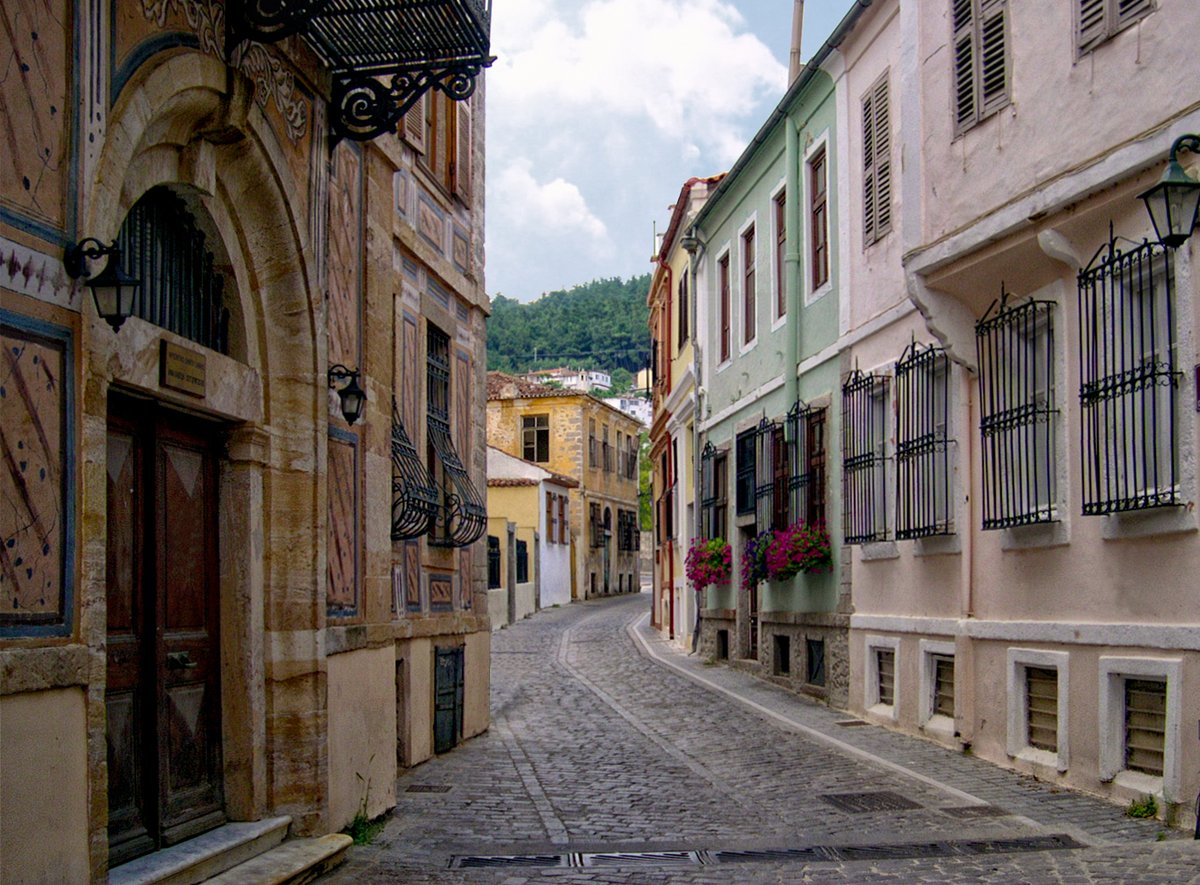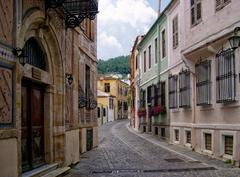
Archontiko Kougioumtzoglou Xanthi, Greece: Visiting Hours, Tickets, and Historical Sites Guide
Date: 14/06/2025
Introduction
Nestled in the heart of Xanthi’s enchanting Old Town, the Archontiko Kougioumtzoglou (Kougioumtzoglou Mansion) stands as an architectural jewel and a testament to the city’s cosmopolitan boom during the late 19th century. Erected around 1870 by the prominent Kougioumtzoglou family—wealthy tobacco merchants—the mansion is a distinguished example of Xanthi’s multicultural heritage, combining neoclassical, Ottoman, and European influences. Today, it houses the Folklore and Historical Museum of Xanthi, offering visitors a window into the city’s social, economic, and cultural evolution.
This comprehensive guide covers the mansion’s history, architectural highlights, museum collections, visiting hours, ticketing, accessibility, cultural events, nearby attractions, and practical travel tips. Whether you are a history enthusiast, a lover of architecture, or a curious traveler, this article will help you make the most of your visit to one of Xanthi’s most treasured historical sites.
Table of Contents
- Introduction
- Historical Background and Architectural Significance
- Museum Collections and Exhibitions
- Visiting Information
- Cultural and Community Significance
- Events and Festivals in Xanthi
- Preservation and Community Engagement
- Practical Tips for Visitors
- Frequently Asked Questions (FAQ)
- Conclusion
- References
Historical Background and Architectural Significance
Origins and Ownership
The Archontiko Kougioumtzoglou was constructed circa 1870 by Vasilios Kougioumtzoglou for his sons, Pantelis and Dimitrios. The mansion’s unique twin structure, with two symmetrical living quarters, was designed to accommodate both sons’ families separately, a testament to the social customs and architectural ingenuity of the era (Old Town Xanthi). The mansion’s right section was donated in 1971 to the House of Letters and Fine Arts of Xanthi, while the left section became the Folklore and Historical Museum, operated by the Progressive Union of Xanthi (F.E.X.) since 1974.
Socio-Economic Context
Xanthi experienced rapid economic and urban development in the late 19th century, driven largely by the thriving tobacco trade. The city’s prosperity attracted architects and artisans from across Europe, resulting in a rich blend of architectural styles. The Kougioumtzoglou family, as leading merchants, embodied this cosmopolitan spirit, commissioning a mansion that symbolized both their wealth and the city’s diverse influences (Greek Reporter, 2024).
Preservation and Architecture
Restored in 2000 and protected by the Ministry of Culture (Government Gazette 73/86), the mansion is a neoclassical masterpiece with Ottoman and eclectic elements. Notable features include:
- Two-storey symmetrical design with a semi-basement
- Façades with triangular and semicircular pediments
- Locally crafted cast iron balconies and ornate window frames
- Elaborate frescoes painted by Bavarian artists in the 1880s
- Private vaulted hammams (baths) in the courtyard—rare in private homes
- A small church (Saints Akindinon), further reflecting the integration of religious and domestic life (Old Town Xanthi)
Location and Urban Context
The mansion is located at Antika 7, Xanthi Old Town, an area renowned for over 1,200 protected historic buildings and a harmonious blend of Byzantine, Ottoman, and neoclassical architecture. It is within walking distance of public squares, the Byzantine walls, and other significant cultural landmarks (By Food and Travel).
Museum Collections and Exhibitions
Permanent Collections
The museum’s 13 exhibition rooms span three floors, illustrating the region’s history and everyday life:
- Ground Floor:
- Showcases the rise of the Greek bourgeoisie, the impact of the tobacco industry, and the lived experience of Xanthi’s urban elite.
- Basement:
- Displays agricultural tools, artifacts from rural Thrace, and exhibits on the city’s working-class and entrepreneurial history.
- Upper Floor:
- Features traditional costumes, textiles, religious icons, jewelry, and household items from Greek, Thracian, Sarakatsani, and Pontian communities (Driver Stories).
Temporary Exhibitions and Educational Programs
The museum regularly organizes temporary exhibitions and educational workshops focused on local history, folk culture, and art. Guided tours are available in Greek and English, and a detailed museum catalog is sold onsite (youingreece.com).
Visiting Information
Visiting Hours
- Tuesday to Sunday: 10:00 AM – 5:00 PM (Last admission: 4:30 PM)
- Closed: Mondays and major public holidays
- Note: Hours may vary during festivals or special events; check the official website for updates.
Ticketing
- General Admission: €5
- Reduced Admission: €3 (students, seniors)
- Children under 12: Free
- Guided Tours: Included in the ticket price or available by prior arrangement (Driver Stories).
Tickets can be purchased at the museum entrance or online via official channels.
Accessibility
- The ground floor is accessible via a portable ramp; upper floors are accessible by stairs only.
- Restrooms, including accessible facilities, are available.
- Contact the museum ahead of time for specific accessibility needs (Down Under Tours Accessibility).
Guided Tours and Events
- Guided tours are offered in Greek and English and last 45–60 minutes.
- Special cultural events, concerts, and workshops are held throughout the year, especially during the Old Town Festival in September and the renowned Xanthi Carnival (Protothema, 2025).
Nearby Attractions
- Old Town Xanthi: Explore cobblestone streets and neoclassical mansions.
- Municipal Art Gallery: Showcases regional art in a historic setting.
- Saturday Bazaar: A vibrant market reflecting the city’s multicultural fabric (Travel Greece).
- Local Taverns: Sample regional cuisine such as bougatsa and kavourmas (Reddit Greece Travel).
Travel Tips and Photography
- Wear comfortable shoes for cobblestone streets.
- Early visits offer softer light for photography and fewer crowds.
- Photography is allowed in most areas, but flash and tripods may be restricted.
Cultural and Community Significance
The Kougioumtzoglou Mansion is a symbol of Xanthi’s multiculturalism, reflecting the coexistence of Greeks, Turks, Pomaks, Armenians, and Jews. The museum’s collections and educational programs document this diversity, emphasizing the city’s transformation through the tobacco trade and its enduring cultural exchanges (Kartalistree). The mansion’s preservation is a collaborative effort involving local authorities and cultural associations.
Events and Festivals in Xanthi
- Xanthi Carnival (February–March): One of Greece’s largest carnivals, featuring parades, concerts, and the “Burning of the Tsar” ceremony.
- Old Town Festival (September): Music, art, and culinary events energize the historic district (By Food and Travel).
- Saturday Bazaar: A longstanding market tradition that brings together diverse communities (Travel Greece).
Practical Tips for Visitors
- Best Visiting Seasons: Spring and autumn offer mild weather and fewer crowds (Champion Traveler).
- Accessibility: The Old Town’s cobblestone streets may present challenges; contact venues in advance if needed.
- Family-Friendly: The museum offers educational activities for children.
- Pets: Only service animals are permitted.
- COVID-19 Measures: Hygiene protocols remain in place; mask use is optional indoors as of June 2025.
Frequently Asked Questions (FAQ)
Q: What are the Kougioumtzoglou Mansion’s visiting hours?
A: Tuesday to Sunday, 10:00 AM–5:00 PM; closed Mondays and public holidays.
Q: How much is admission?
A: General admission is €5; €3 for students and seniors; children under 12 enter free.
Q: Are guided tours available?
A: Yes, in Greek and English—book in advance for guaranteed availability.
Q: Is the mansion accessible for visitors with disabilities?
A: The ground floor is accessible; upper floors are only accessible by stairs.
Q: Can I take photos inside?
A: Photography is allowed in most areas, but flash and tripods may be restricted.
Q: How do I book tickets or tours?
A: Tickets and tours can be booked onsite or online via the official museum website.
Conclusion
The Archontiko Kougioumtzoglou is more than an architectural landmark—it is a living museum that preserves and celebrates Xanthi’s rich multicultural legacy. Its neoclassical grandeur, Ottoman-influenced features, and immersive exhibitions offer an enlightening journey through the city’s history. Visitors are encouraged to explore the mansion, participate in its cultural events, and discover the vibrant life of Xanthi’s Old Town. For the latest information, digital resources, and interactive maps, consult the official museum website or download the Audiala app for a seamless and enriching experience.
References
- This article draws on official and reputable sources to provide accurate, up-to-date information. For further reading and planning, visit:
Visual enhancements such as alt-tagged images (“Kougioumtzoglou Mansion facade in Xanthi”) and interactive maps are strongly recommended for website integration to optimize user engagement and SEO.
